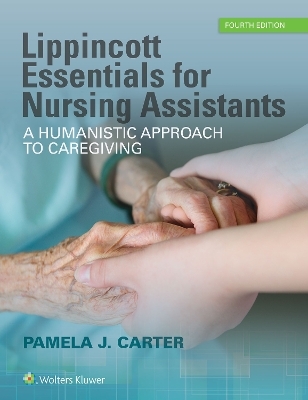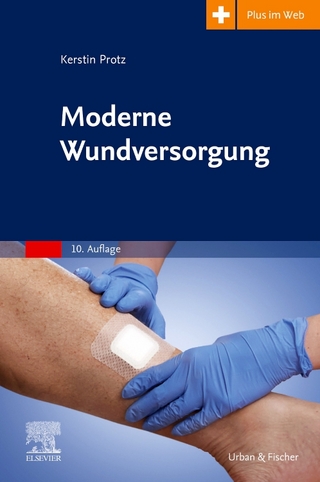
Lippincott Essentials for Nursing Assistants
Lippincott Williams and Wilkins (Verlag)
978-1-4963-3956-0 (ISBN)
- Titel erscheint in neuer Auflage
- Artikel merken
This easy-to-understand, conversational text focuses on the most essential information that nursing assistants need to know to function competently and compassionately in a long-term care facility, acute care facility, or home health care agency. Each chapter of the new edition has been updated to reflect the latest best practices and advances in the field.
KEY FEATURES
NEW! A separate unit on Long-Term Care c overs nursing assistant care with residents in long-term care settings.
UPDATED! Procedure boxes present 71 core procedures with step-by-step instructions that incorporate the latest guidelines and NNAAP skill revisions.
UPDATED! Nurse Pam tips promote compassionate, holistic care and help students empathize with their patients.
Guidelines ( What You Do/Why You Do it ) boxes summarize both the whys and the hows of carrying out key nursing assistant actions.
Tell the Nurse! Notes summarize observations that the nursing assistant needs to report to the nurse.Stop and Think!Scenarios encourage students to solve real world problems in the types of complex situations they will encounter in the workplace.
Online videos featuring eight hours of engaging footage offer complete, step-by-step demonstrations of the core skills performed daily by nursing assistants.
An accompanying Workbook follows the same straightforward organization as the 4th Edition Textbook. Activities include multiple-choice, fill-in-the-blanks, think about it, and matching questions, as well as crossword puzzles, word jumbles, labeling, sequencing, and identification.
Pamela Carter is a registered nurse and an award-winning teacher. After receiving her bachelor’s degree in nursing from the University of Alabama in Huntsville, Pamela immediately began a career as a perioperative nurse. Over the course of her nursing career, she also worked in a physician’s office and as a staff nurse in an intensive care unit.Pamela started teaching informally while serving as an officer in the United States Air Force Nurse Corps. She formally entered the field of health care education by accepting a position at the Athens Area Technical Institute in Athens, Georgia, where she taught surgical technology. After obtaining a master’s degree in adult vocational education from the University of Georgia, Pamela moved to Florida and took a position teaching nursing assisting students. She continued teaching nursing assisting after accepting a position at Davis Applied Technology College in Kaysville, Utah. During her first year at Davis Applied Technology College, Pamela piloted a new “open-entry/open-exit” method of curriculum delivery for the nursing assistant program at the college and was awarded the Superintendent’s Award for Outstanding Faculty for her work. She then opened a surgical technology program at the college and has obtained national accreditation from the Commission on Accreditation of Allied Health Education Programs (CAAHEP) for delivery of this program using the “open-entry/open-exit” method. In 2002,and again in 2014 and 2015, Pamela received a National Merit Award for having her program rank in the top 10% in the nation for students passing their national certification exam. In addition to authoring this textbook, Pamela has also authored Lippincott’s Textbook for Nursing Assistants, “Lippincott’s Textbook for Long-Term Care Nursing Assistants,” as well as Lippincott’s Advanced Skills for Nursing Assistants. Pamela’s writing style reflects her love of teaching, and of nursing. She is grateful for the opportunity teaching and writing have afforded her to share her experience and knowledge with those just entering the health care profession, and to help those who are new to the profession to see how they can have a profound effect on the lives of others.
Table of Contents
UNIT ONE: INTRODUCTION TO HEALTH CARE
Chapter 1: The Health Care System
A Holistic Approach to Health Care
Health Care Organizations
Patients, Residents, and Clients
Oversight of the Health Care System
Paying for Health Care
Chapter 2: The Nursing Assistant’s Job
Education of the Nursing Assistant
The Nursing Assistant as a Member of the Nursing Team
Legal and Ethical Aspects of the Nursing Assistant’s Job
Chapter 3: Professionalism and Job-Seeking Skills
Working as a Professional
Finding a Job
Chapter 4: Communication Skills
Introduction to Communication
Communicating with People with Special Needs
Resolving Conflicts
Using the Telephone
Communication Among Members of the Health Care Team
Electronic Health Records
Chapter 5: Those We Care For
Growth and Development
Basic Human Needs
Human Sexuality and Intimacy
Culture and Religion
Quality of Life
What is it Like to be a Patient or Resident
A Person’s Family
Chapter 6: The Patient’s or Resident’s Environment
The Physical Environment
Furniture and Equipment
UNIT TWO: THE HUMAN BODY IN HEATLH AND DISEASE
Chapter 7: Basic Body Structure and Function
How is the Body Organized?
The Integumentary System
The Musculoskeletal System
The Respiratory System
The Cardiovascular System
The Nervous System
The Sensory System
The Endocrine System
The Digestive System
The Urinary System
The Reproductive System
Chapter 8: Common Disorders
Introduction to Disorders
Integumentary Disorders
Musculoskeletal Disorders
Respiratory Disorders
Cardiovascular Disorders
Nervous System Disorders
Sensory Disorders
Endocrine Disorders
Digestive Disorders
Urinary Disorders
Reproductive Disorders
Mental Health Disorders
Chapter 9: Rehabilitation and Restorative Care
Introduction to Rehabilitation and Restorative Care
Types of Rehabilitation
The Role of the Nursing Assistant
UNIT THREE: LONG-TERM CARE (New Unit)
Chapter 10: Overview of Long-Term Care
Types of Long-Term Care Settings
Ownership and Operation of Long-Term Care Facilities
Oversight of Long-Term Care
The Survey Process
Paying for Long-Term Care
Chapter 11: The Long-Term Care Resident
Our Aging Population
Factors Leading to Long-Term Care Admissions
Making the Adjustment to Long-Term Care
Living with a Chronic Condition
The Young Resident
Chapter 12: Caring for People With Dementia
Introduction to Dementia
Types of Dementia
Behaviors Associated with Dementia
Caring for a Person With Dementia
Effects on the Caregiver
UNIT FOUR: SAFETY
Chapter 13: Infection Control
Causes of Infection
Defenses Against Infection
Ways Infections are Transmitted
The Chain of Infection
Methods of Infection Control
Occupational Safety and Health Administration (OSHA) Bloodborne Pathogens Standard
Chapter 14: Workplace Safety
Protecting Your Body
Following Procedures
Fire Safety
Preventing Chemical and Electrical Injuries
Disaster Preparedness
Workplace Violence
Chapter 15: Patient and Resident Safety
Accidents and Incidents in the Health Care Setting
Restraints and Restraint Alternatives
Chapter 16: Basic First Aid and Emergency Care
Responding To An Emergency
Basic Life Support (BLS) Measures
Emergency Situations
UNIT FIVE: BASIC PATIENT AND RESIDENT CARE
Chapter 17: Assisting With Repositioning and Transferring
Assisting With Repositioning
Assisting With Transferring
Chapter 18: Assisting With Exercise
Assisting With Walking (Ambulation)
Assisting With Range-of-Motion Exercises
Chapter 19: Bedmaking
Linens
Standard Bedmaking Techniques
Chapter 20: Measuring and Recording Vital Signs, Height, and Weight
Introduction to Vital Signs
Body Temperature
Pulse
Respiration
Pulse oximetry
Blood Pressure
Height and Weight
Chapter 21: Assisting With Hygiene
Introduction to Personal Hygiene
Assisting with Oral Care
Assisting with Perineal Care
Assisting with Bathing
Chapter 22: Preventing Pressure Ulcers and Assisting With Wound Care
Preventing Pressure Ulcers
Assisting With Wound Care
Chapter 23: Assisting With Grooming
Introduction to Grooming
Assisting with Hand Care
Assisting With Foot Care
Assisting with Dressing and Undressing
Assisting with Hair Care
Assisting with Shaving
Assisting with Vision and Hearing Accessories
Chapter 24: Assisting With Nutrition
Introduction to Nutrition
Factors that Affect Food Choices and Eating Habits
Special Diets
Assisting With Meals
Assisting With Fluids
Alternative Ways of Providing Nutrition and Fluids
Chapter 25: Assisting With Urinary Elimination
Introduction to Urinary Elimination
Assisting With Bedside Commodes, Bedpans, and Urinals
Caring for a Person With an Indwelling Urinary Catheter
Caring for a Person Who is Incontinent of Urine
Obtaining a Urine Specimen
Measuring Urine Output
Chapter 26: Assisting With Bowel Elimination
Introduction to Bowel Elimination
Problems With Bowel Elimination
Obtaining a Stool Specimen
Assisting With Enemas
Assisting With Ostomy Care
Chapter 27: Assisting With Comfort and Rest
The Benefits of Rest and Sleep
General Comfort Measures
Managing Pain
Heat and Cold Applications
UNIT SIX: SPECIAL CARE CONCERNS
Chapter 28: Caring for People Who Are Dying
Terminal Illness
Advance Directives and Wills
Attitudes Toward Death and Dying
Care and Support of the Dying Person and the Family
Postmortem Care
Chapter 29: Caring for People with Developmental Disabilities
Introduction to Developmental Disabilities
Education and Protection of Rights
Caring for People With Developmental Disabilities
Chapter 30: Caring for People with Cancer
Introduction to Cancer
Detecting and Treating Cancer
Caring for a Person with Cancer
Chapter 31: Caring for People with HIV/AIDS
Introduction to HIV/AIDS
Attitudes Toward People With HIV/AIDS
Caring for a Person with HIV/AIDS
Chapter 32: Caring for People Who Are Having Surgery
Introduction to Surgery
Pre-Operative Care
Intra-Operative Care
Post-Operative Care
Oxygen Therapy
Chapter 33: Caring for People in the Home Environment
Introduction to Home Health Care
The Home Health Aide
The Home Health Care Environment
Infection Control
Appendix A: Answers to What Did You Learn? Questions
Appendix B: Introduction to the Language of Health Care
Glossary
Index
| Erscheinungsdatum | 06.01.2017 |
|---|---|
| Reihe/Serie | Lippincott Essentials |
| Zusatzinfo | 406 |
| Verlagsort | Philadelphia |
| Sprache | englisch |
| Maße | 213 x 276 mm |
| Gewicht | 1610 g |
| Themenwelt | Medizin / Pharmazie ► Pflege ► Ausbildung / Prüfung |
| ISBN-10 | 1-4963-3956-8 / 1496339568 |
| ISBN-13 | 978-1-4963-3956-0 / 9781496339560 |
| Zustand | Neuware |
| Haben Sie eine Frage zum Produkt? |
aus dem Bereich



